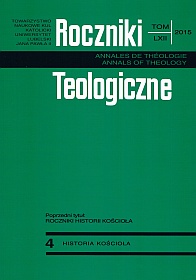Reorganizing the Archdiocese of Gniezno in Accord with the Bull of Circumscription Vixdum Poloniae Unitas of 1925
Abstract
The Patritions of Poland introduced a demarcation line within the historically united territory of the Archdiocese of Gniezno. Some of its was incorporated into Russia, while the other into Prussia. Gniezno - the bishop's seat - was located in the Hohenzollerns' state, along with its canonical area consisting of 3 separate districts. When Poland reached for independence, the Catholic Church found itself in an urgent need to reorganize its territorial structure, so as to become effective in its pastoral mission in the new circumstances. This problem was scrutinized by the Polish Episcopate in the years 1919-1924. A number of conceptions were developed for how to redefine the borders of the particular dioceses. Some of these reflections are visible in the Bull of Circumscription issued by Pius XI Vixdum Poloniae Unitas as of 28 October 1925.This document announced the emergence of two new metropolises: of Cracow and Lviv; and of four new dioceses: of Częstochowa, Katowice, Łomża and Pinsk. Of considerable import were also papal decisions as for the structure and organization of the Archdiocese of Gniezno. The pope decreed that two Poznań deaconries − of Miłosław and Jarocin − be integrated within the Archdiocese of Gniezno (with 23 parishes altogether). At the same time, the deaconries of Ołobok and Krotoszyn (24 parishes) were separated from Gniezno, and integrated within the Poznań archdiocesan structure. This reorganization eliminated enclaves in the Archdiocese of Gniezno and produced a structurally coherent ecclesiastic unit, which covered about 12000 sq.km. The resultant territorial organization remained valid until 1992, that is untilJohn Paul II's Bull Totus Tuus Poloniae Populus.
References
Aleksandrowicz M., Edmund Dalbor 1915-1926, w: Na stolicy prymasowskiej w Gnieźnie i w Poznaniu. Szkice o prymasach Polski w okresie niewoli narodowej i w II Rzeczypospolitej, red. F. Lenort, Poznań 1982, s. 293-318.
Guzewicz W., Zagadnienie organizacji kościelnej w Drugiej Rzeczypospolitej, „Kościół wPolsce. Dzieje i Kultura” 12 (2013), s. 115-127.
Kopiczko A., Reorganizacja Kościoła katolickiego w Prusach na podstawie bulli „De salute animarum”, „Kościół w Polsce. Dzieje i Kultura” 12 (2013), s. 65-85.
Krucki Ł., Archidiecezja gnieźnieńska i jej granice w dokumentach Stolicy Apostolskiej (od wieku XIX do początku XXI), „Kościół w Polsce. Dzieje i Kultura” 12 (2013), s. 87-114.
Kumor B., Granice archidiecezji gnieźnieńskiej w tysiącleciu (1000-1939), „Prawo Kanoniczne” 9 (1966), nr 3-4, s. 3-26.
Kumor B., Granice metropolii i diecezji polskich (966-1939), „Archiwa, Biblioteki i Muzea Kościelne” 21 (1970), s. 309-404.
Kumor B., Projekt zmian organizacji metropolitalnej i diecezjalnej w Polsce (1918-1925), w: Kościół w Drugiej Rzeczypospolitej, red. Z. Zieliński, S. Wilk, Lublin 1981, s. 53-62.
Kumor B., Ustrój i organizacja Kościoła polskiego w okresie niewoli narodowej (1772-1918), Kraków 1980.
Nowacki J., Archidiecezja poznańska w granicach historycznych i jej ustrój, t. 2, Poznań 1964.
Pest Cz., Kardynał Edmund Dalbor (1869-1926). Pierwszy Prymas Polski Odrodzonej, Poznań 2004.
Szatkowski H., Okoniewski Stanisław Wojciech, w: Księża społecznicy w Wielkopolsce 1894-1919, t. 2, red. L. Wilczyński, H. Szatkowski, Gniezno 2007, s. 371-375.
Urban W., Ostatni etap dziejów Kościoła w Polsce przed nowym tysiącleciem (1815-1965), Rzym 1966.
Wilk S., Archidiecezja gnieźnieńska w II Rzeczpospolitej. Administracja archidiecezji pod rządami prymasów kard. Edmunda Dalbora i kard. Augusta Hlonda, Lublin 1987.
Wilk S., Episkopat Kościoła katolickiego w Polsce w latach 1918-1939, Warszawa 1992.
Wyczawski H.E., Organizacja kościelna, w: Historia Kościoła w Polsce, t. II, cz. 2, red. B.Kumor, Z. Obertyński, Poznań−Warszawa 1979, s. 22-44.
Zakrzewski T., Dalbor Edmund, w: Polski Słownik Biograficzny, t. 4, red. W. Konopczyński, Kraków 1938, s. 391-392.
Zieliński Z., De salute animarum, w: Encyklopedia Katolicka, t. 3, red. R. Łukaszyk, Lublin 1985, kol. 1191-1192.
Zieliński Z., Katolicka mniejszość niemiecka w archidiecezji gnieźnieńskiej i poznańskiej oraz diecezji chełmińskiej: 1918-1939, w: 1000 lat Archidiecezji Gnieźnieńskiej, red. J.Strzelczyk, J. Górny, Gniezno 2000, s. 369-377.
Copyright (c) 2015 Roczniki Teologiczne

This work is licensed under a Creative Commons Attribution-NonCommercial-NoDerivatives 4.0 International License.





